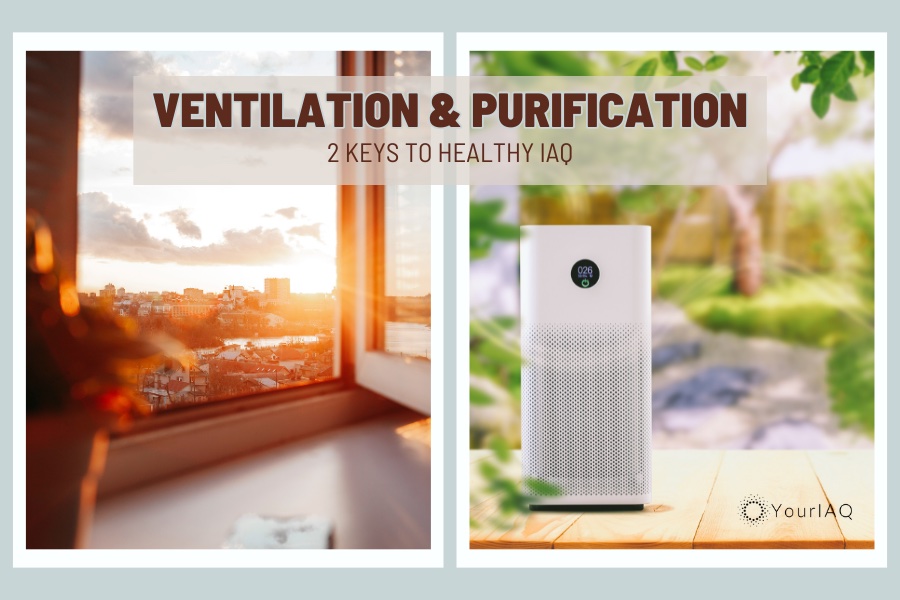
Ensuring clean and healthy indoor air is paramount for your well-being and that of your family. Indoor air quality significantly impacts our health, especially considering the amount of time we spend indoors. In this overview we will explore two essential components of maintaining pristine indoor air: ventilation and purification. We’ll discuss what they are, the various types of systems available, their benefits, and provide practical tips for improving your indoor air quality. As indoor air quality changes it is important to stay up to date on the options for managing indoor air.
What is Ventilation Purification?
Ventilation purification is a comprehensive approach to ensuring the air inside your home or office is clean and fresh. It combines two essential elements:
- Ventilation: The process of replacing stale indoor air with fresh outdoor air to dilute pollutants and maintain balanced oxygen levels.
- Purification: The removal of contaminants, such as dust, allergens, mold, and pathogens, to create a healthier living environment.
By integrating these two strategies, you can effectively combat indoor air pollutants and provide a comfortable and healthy atmosphere for yourself and your loved ones.
Different Types of Ventilation Purification Systems
There are various systems available to achieve ventilation purification, each catering to different needs and budgets. Here are some common types:
- Mechanical Ventilation: This system uses fans and ducts to bring outdoor air inside and expel indoor air, continuously refreshing the indoor environment.
- Air Purifiers: These devices use filters, such as HEPA filters or activated carbon filters, to capture and remove particles, allergens, and pollutants from the air.
- Natural Air Purifiers: Although they make a small impact on your air, the use of plants to purify your indoor air can be beneficial.
- UV-C Air Purifiers: Ultraviolet (UV-C) light is used to kill or inactivate microorganisms like bacteria and viruses, enhancing the purification process.
- Heat Recovery Ventilators (HRVs) and Energy Recovery Ventilators (ERVs): These systems exchange heat between indoor and outdoor air, reducing energy loss while ventilating.
- Whole-House Air Filtration Systems: Installed in your HVAC system, these systems provide extensive air purification throughout your home.
Benefits of Using a Ventilation Purification System
Investing in a ventilation purification system offers numerous benefits:
- Improved Health: Reducing indoor air pollutants can alleviate allergy symptoms, respiratory issues, and promote overall well-being.
- Enhanced Comfort: Fresh, clean air is more comfortable to breathe and can improve sleep quality.
- Energy Efficiency: Some systems, like HRVs and ERVs, help maintain indoor temperatures efficiently.
- Odor Removal: Air purifiers can eliminate unpleasant odors, leaving your home smelling fresh.
- Reduced Risk of Illness: By removing pathogens, you can reduce the risk of infections and illnesses.
How Can I Improve the Ventilation in My Home or Office?
Improving ventilation is vital for maintaining good indoor air quality. Here are some practical tips:
- Open Windows and Doors: Let fresh air in regularly, especially when the weather permits.
- Use Exhaust Fans: Install exhaust fans in kitchens and bathrooms to remove pollutants generated during cooking and bathing.
- Ventilation Systems: Consider mechanical ventilation systems that continuously exchange indoor and outdoor air.
- Regular Maintenance: Keep HVAC systems and filters clean and well-maintained to ensure efficient ventilation.
- Air Purifiers: Invest in air purifiers to complement ventilation and remove indoor pollutants.
What Are the Best Air Purifiers for Ventilation Purification?
Choosing the right air purifier is crucial for effective purification. Look for purifiers with HEPA filters for capturing particles and activated carbon filters for odors. Some popular brands include Dyson, Blueair, and Honeywell.
How Do I Clean My Air Ducts?
Cleaning air ducts can significantly improve ventilation and reduce dust and allergens. It’s recommended to hire a professional duct cleaning service. Ensure they follow industry standards and guidelines.
How Do I Get Rid of Mold in My Home?
Mold can be a serious IAQ issue. To remove it, identify the source of moisture, fix leaks, and consider hiring a mold remediation specialist. Ensure proper ventilation to prevent future mold growth.
How Do I Reduce the Risk of Respiratory Problems Caused by Indoor Air Quality?
To reduce the risk of respiratory problems, maintain good IAQ by:
- Ventilating regularly
- Using air purifiers
- Keeping indoor humidity between 30-50%
- Reducing exposure to tobacco smoke
Ventilation Purification FAQ
Can a ventilation purification system remove dust mites?
Yes, a ventilation purification system with HEPA filters can effectively remove dust mites and their allergens.
Can a ventilation purification system remove pollen?
Yes, HEPA filters in ventilation purification systems can capture pollen particles.
Can a ventilation purification system remove pet dander?
Yes, air purifiers with HEPA filters are efficient at removing pet dander.
Can a ventilation purification system remove mold spores?
Yes, a well-maintained ventilation purification system can help reduce indoor mold spores.
Can a ventilation purification system remove smoke?
Yes, air purifiers equipped with activated carbon filters can effectively remove smoke particles and odors.
Can a ventilation purification system remove viruses and bacteria?
Yes, some systems, like UV-C air purifiers, can inactivate or kill viruses and bacteria, enhancing indoor air quality.







